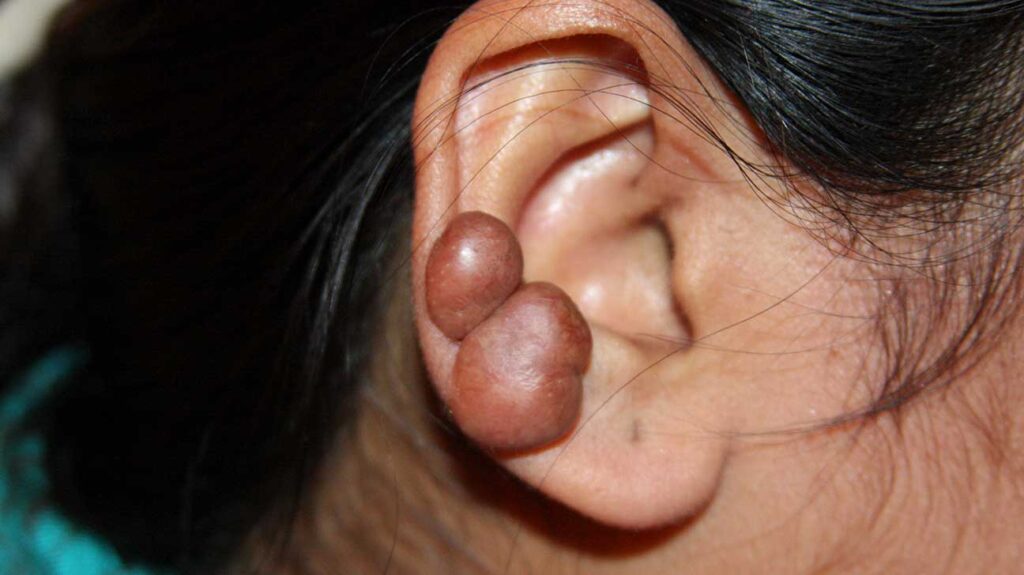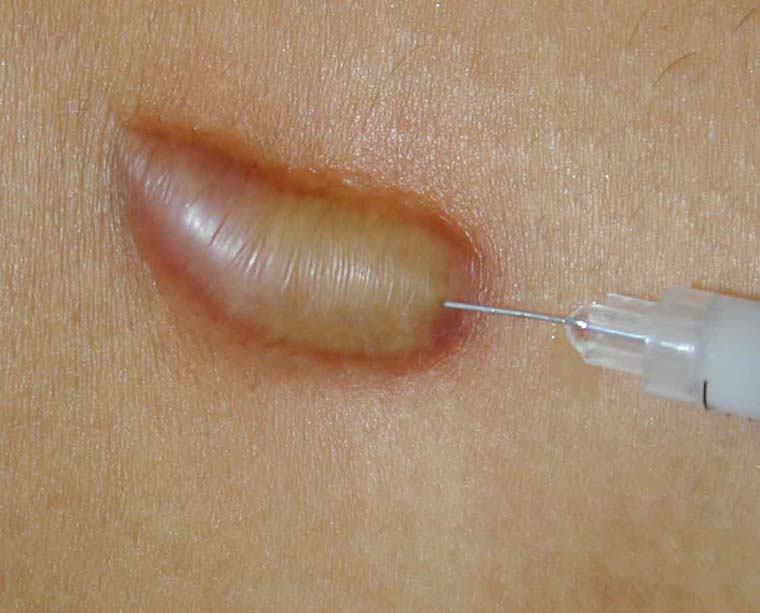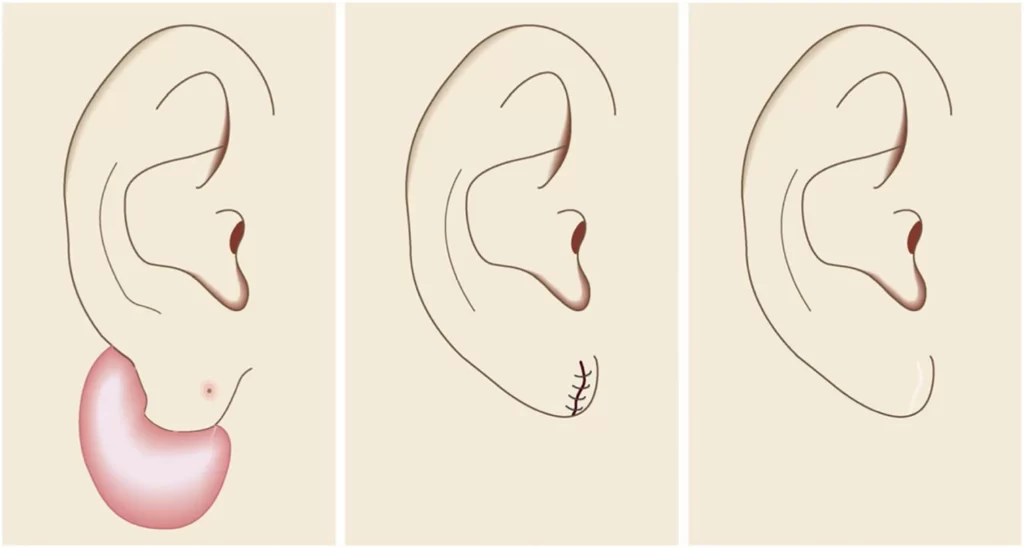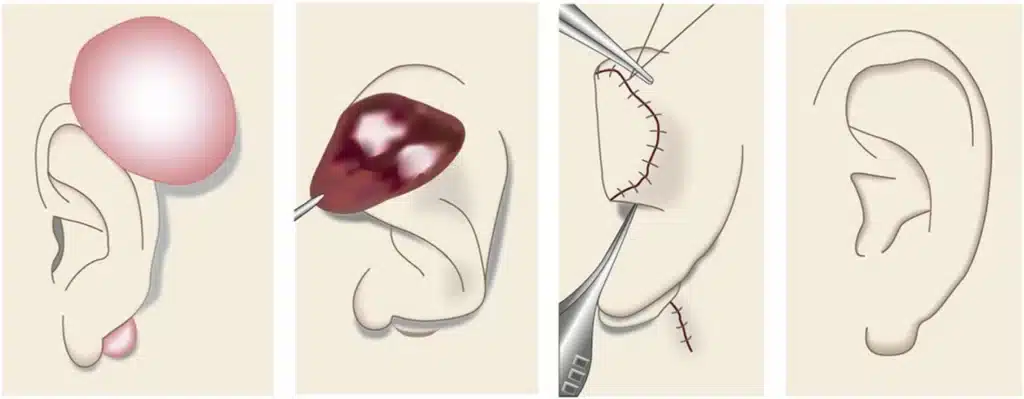Keloids and hypertrophic scars are large, thickened and raised red growths. They result from an abnormal healing response characterized by an exuberant inflammatory reaction to injury and subsequent excessive collagen deposition.
Keloids and hypertrophic scars can develop after any sort of skin injury. Common causes include:
Keloids tend to occur in darker skin types with a family history of keloids, particularly on the jawline, ears, chest, back, and shoulders.
Patients with keloids in Singapore often seek keloid removal treatment as
Keloids are notoriously difficult to treat and proper keloid removal by a medical professional is essential. Unqualified treatment such as from spa or facial consultants or inexperienced practitioners may worsen the keloid.

CO2 laser is strongly absorbed by water in cells under the skin. Laser energy vaporizes a layer of skin cells together with a surrounding zone of coagulation. Ultrapulse CO2 produces very short pulses of laser energy with high peak power. The amount of tissue vaporization vs coagulation can be tailored, allowing for vaporization of only the abnormal tissue without causing too much collateral damage. Ultrapulse CO2 can be used for keloid removal surgical techniques resulting in successful keloid removal treatment.
High frequency radiofrequency is strongly absorbed by water in cells causing vaporization or coagulation depending on the waveform. It can be used to dissect out keloids or coagulate them. Insulated needles can also be used to treat the deep portion of the keloid while sparing the skin surface, reducing the downtime and chance of scarring.
Vascular laser keloid removal utilizes wavelengths that target haemoglobin in blood vessels supplying the keloid. The long pulse duration produces a photothermal effect that causes damage to the walls of the blood vessels. The body then naturally eliminates the damaged vessels feeding the keloid, reducing redness and shrinking the keloid.
The most suitable vascular laser would depend on the characteristics of the keloid so it is important to have access to more than one vascular laser for various stages of keloid removal treatment. Longer wavelengths such as 940nm diode would be more suitable for larger or thicker keloids whereas shorter wavelengths such as the 585nm laser are more suitable for flatter keloids that are persistently red.


Cold steel, ultrapulse CO2, vascular lasers or high-frequency radiofrequency can be used to dissect the keloid.
Multiple types of keloid removal surgeries have been tried, ranging from simpler techniques such as shave excision, full thickness extra-lesional (around the keloid) excision, to more advanced techniques such as intralesional fillet flaps.
Regardless of the method used, surgery has dual aims - to remove the bulk of the keloid and reduce the risk of recurrence. It is important to assess the keloid to determine if keloid removal surgery would be suitable, as well as what surgical technique would give the best aesthetic outcome. During surgical keloid removal, it is critical to remove as much abnormal keloid as possible while reducing factors such as tissue damage, bleeding, wound tension and infection that could increase the risk of recurrence. Thus, tools such as ultrapulse CO2, vascular lasers or high-frequency radiofrequency that cut and cauterize at the same time are favoured.
Corticosteroid injection is an established keloid removal treatment that decreases over-active inflammation and collagen synthesis, hence improving the appearance and symptoms of keloid or hypertrophic scars. They are used both as a standalone treatment or following keloid removal with laser or surgery. Care must be taken with the concentration, amount, and depth of injections to avoid complications like skin atrophy or sunken-ness.


Neurotoxins are increasingly being used off-label for keloid treatment. They have been shown in multiple published studies to alleviate the symptoms of pain and itching, as well as reduce the keloid thickness, particularly in combination with intralesional steroid injections. They have less risk of side effects such as injection pain and skin atrophy.
Keloids are a very common medical aesthetic concern. Even regular people who would not otherwise step into a medical aesthetics clinic seek keloid removal treatment in Singapore. For example, young girls that develop ear keloids after botched piercings, knee keloids after a fall, or young men with acne-induced keloid scarring along the jawline. Keloids can also develop after mole removal procedures.
Many Singapore medical aesthetic clinics offer intralesional steroid injections or laser keloid treatment. These work quite well for relatively flat and small keloids. In Dr Wan's experience, combination treatment with lasers and various injections works better with a faster, more complete response and fewer complications, compared to just using traditional intralesional steroid injections.
Conservative treatment would take much longer to whittle down the bulk of big protruding keloids,. This necessitates a long course of treatment with slow results, additional costs, and more discomfort. Furthermore, the dense collagen built up in the hard, fibrous keloid core may not respond much to conservative treatment. Read more about what the inside of a keloid is filled with and how it affects keloid removal.

FOUNDER / MEDICAL DIRECTOR



For selected keloids that are suitable, surgical removal with newer more advanced techniques with lower recurrence rates can be considered to remove the keloid. However, keloid removal surgery is messy, bloody, and fraught with difficulties, chief amongst these being a high recurrence rate. Thus, it may be hard to find a doctor specializing in keloid removal surgery as many doctors steer clear of it.
In particular, simply shaving off the keloid (even with a laser) almost always results in the keloid growing back rapidly. Dr. Wan feels that there is no point in this and prefers more precise and nuanced surgery that preserves the skin coverage, reduces the healing time, and greatly reduces the risk of recurrence.
Many patients think that they have been cured when the keloids reduce in size or flatten after keloid scar removal surgery or non-surgical treatments such as steroid injections. They then discontinue treatments only to find the keloid regrowing.
Keloid suppression treatment with keloid removal creams, lasers and injections must go hand in hand with keloid scar removal treatments in order to get rid of keloid scars permanently. A period of suppression is absolutely necessary to prevent recurrence.
Proper assessment of the keloid is imperative in determining the best course of action to take for fast and effective keloid removal in Singapore. Thick, firm or mature keloids may benefit more from keloid removal surgery, whereas softer, younger keloid scars may only need non-surgical lasers and injections.
Address:
1Aesthetics, Medical & Surgery
#14-90 The Central Tower 1
8 Eu Tong Sen Street
Singapore 059818
Mon-Fri 9 AM to 7 PM
Sat 9 AM to 3 PM
Phone / WhatsApp:
+65 66125173 / +65 84899962
Email:
[email protected]